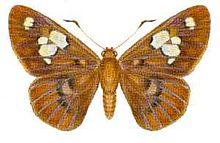
Skippers are a group of butterflies placed in the family Hesperiidae within the order Lepidoptera. They were previously placed in a separate superfamily, Hesperioidea; however, the most recent taxonomy places the family in the superfamily Papilionoidea, the butterflies. They are named for their quick, darting flight habits. Most have their antenna tips modified into narrow, hook-like projections. Moreover, skippers mostly have an absence of wing-coupling structure available in most moths. More than 3500 species of skippers are recognized, and they occur worldwide, but with the greatest diversity in the Neotropical regions of Central and South America.

Grass skippers or banded skippers are butterflies of the subfamily Hesperiinae, part of the skipper family, Hesperiidae. The subfamily was established by Pierre André Latreille in 1809.
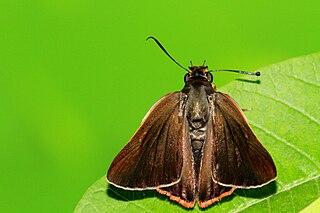
Bibasis sena, commonly known as the orange-tailed awlet, is a butterfly belonging to the family Hesperiidae, the skippers. It is also sometimes called the pale green awlet though that name can also refer to Bibasis gomata.

Choaspes benjaminii,also known as the Indian awlking or common awlking, is a species of butterfly in the family Hesperiidae. The species is named after Benjamin Delessert and was described on the basis of a specimen collected by Adolphe Delessert in the Nilgiris.

Hasora badra, the common awl, is a butterfly belonging to the family Hesperiidae, which is found in India.
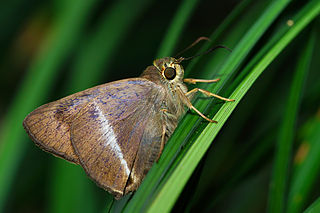
Hasora taminatus, the white banded awl, is a butterfly belonging to the family Hesperiidae, which is found in Asia.

Tagiades, commonly known as snow flats, is a genus of spread-winged skipper butterflies. It is the type genus of the tribe Tagiadini of the subfamily Pyrginae in the family Hesperiidae. It contains seventeen species; three of which are found in tropical Africa, while fourteen are found from India, Sri Lanka, Southeast Asia, northeast Australia, to the Pacific Islands. They are primarily diurnal butterflies, and can usually be found in secondary forests at up to 1,300 m (4,300 ft) above sea level. They can sometimes be encountered in partially cleared or cultivated areas. They are fast flyers, flying at an average height of 2 to 6 m. They usually rest on the undersides of leaves. When disturbed they will fly away but will usually return to the preferred area, often to the same leaf.

Bibasis vasutana, the green awlet, is a species of hesperid butterfly found in Asia. The butterfly was reassigned to genus Burara by Vane-Wright and de Jong (2003) and is considered by them to be Burara vasutana.

Hasora anura, the slate awl, is a species of hesperid butterfly found in Asia. In India it is found in Sikkim and the Khasi Hills.

Hasora khoda, the large banded awl, is a butterfly belonging to the family Hesperiidae which is found in India, parts of Southeast Asia and Australia.
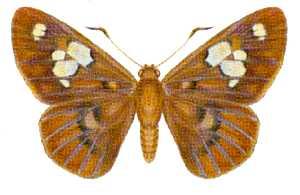
Chaetocneme denitza, commonly known as the rare red-eye or ornate dusk-flat, is a species of butterfly in the skipper family Hesperiidae. It is endemic to Australia.

Chamunda chamunda is a species of spread-winged skipper in the family Hesperiidae. It is the only species in the monotypic genus Chamunda and the monotypic subfamily Chamundinae. It is found from Assam to Burma, Thailand, Laos, Peninsular Malaysia and possibly Java.

Pasma tasmanicus, the two spotted grass skipper, is the only species in the monotypic butterfly genus Pasma of the family Hesperiidae. The genus was erected by Gustavus Athol Waterhouse in 1932. The species was first described by William Henry Miskin in 1889. It is found in the Australian states of New South Wales, South Australia, Tasmania and Victoria.

Chaetocneme porphyropis, the purple brown-eye or purple dusk-flat, is a species of butterfly of the family Hesperiidae endemic to tropical Queensland, between Innisfail and Daintree on the Atherton Tableland. Its wingspan is about 60 mm. The larvae feed on various Lauraceae species, including Cinnamomum camphora, Cryptocarya grandis, Endiandra compressa, Litsea leefeana, and Neolitsea dealbata.

Chaetocneme critomedia, the banded red-eye or banded dusk-flat, is a species of butterfly of the family Hesperiidae. It is found in Indonesia, New Guinea and Australia.

Chaetocneme beata, also known as the common red-eye, eastern dull-flat or eastern dusk-flat, is a species of butterfly in the family Hesperiidae. It is found in Australia on the edges of the upland rainforest along the coast of Queensland and New South Wales.

Litsea leefeana, known as the brown bolly gum or brown bollywood is a rainforest tree in the laurel family. A small to medium-sized tree endemic to the rainforests of tropical Queensland, Australia.
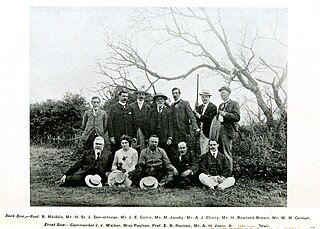
Hamilton Herbert Charles James Druce was an English entomologist who specialised in Lycaenidae and to a lesser extent Hesperiidae. He is not to be confused with his father, the English entomologist Herbert Druce (1846–1913) who also worked on Lepidoptera.

The Erionotini are a tribe of skipper butterflies in the subfamily Hesperiinae.
